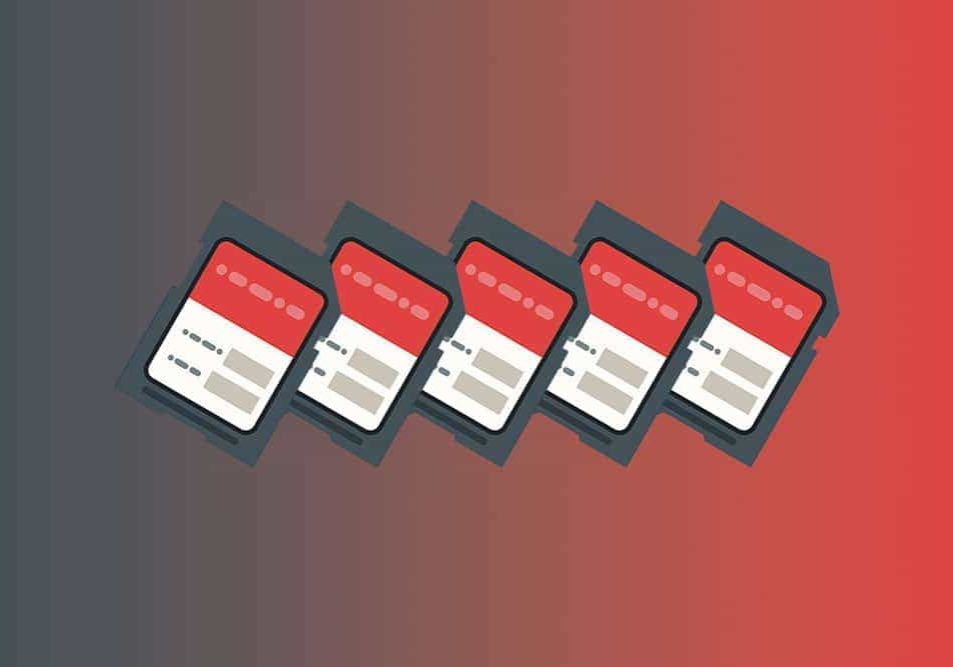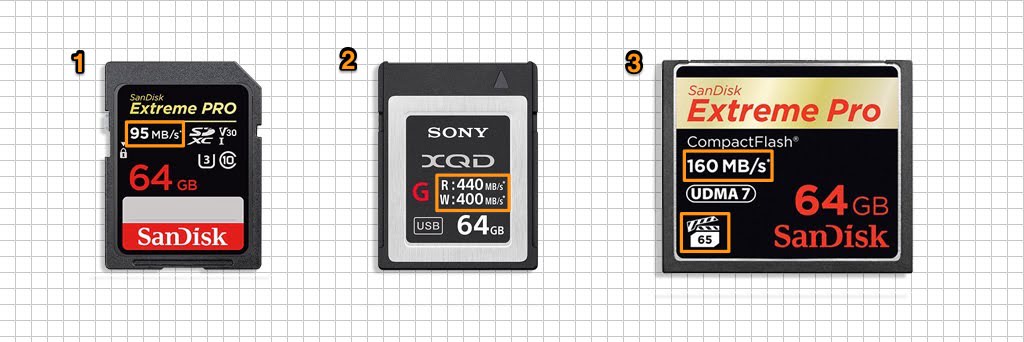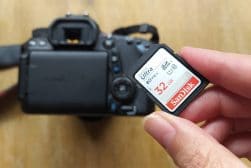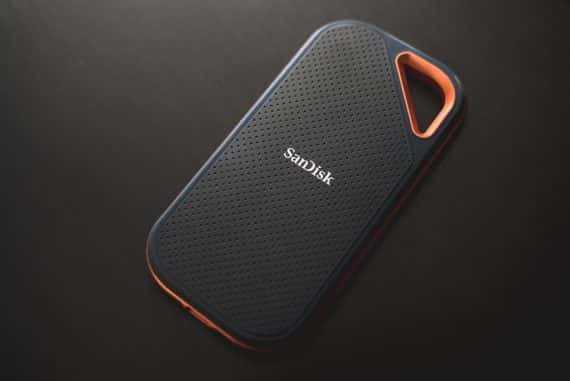
Best Memory Card for Photographers in 2024 (Fastest Transfers)
If you're confused about what memory card you need for the best performance, read this in depth guide to choosing memory cards for your camera.
It may seem like a boring topic, but choosing what memory card to buy for your camera is actually really important.
They may only be small, plastic, seemingly-insignificant things, but choosing the right one is an essential step for your photography.
In this guide, I’ve included cards of various capacities, but only those with above-average speeds.
If you come across a cheaper card by a reputable manufacturer from a reputable vendor, it’s likely that the speed of the card may be a limiting factor.
I recommend you stick to the brands mentioned below, so let’s check out which of the various SD and CF cards you should be using in your cameras in 2024.
What Memory Card is Best for Cameras in 2024?
1. Small Capacity SD Cards
- SanDisk Extreme 16 GB SDHC UHS-I SD Card

Format: SDHC
Capacity: 16 GB
Read speed: 90 MB/s
Price: Approx. $11 – Click here to see latest price
SanDisk rules the roost when it comes to the best SD cards, and this one offers great value for money, fast, reliable memory card.
The 16 GB storage capacity will be adequate for most low-mid range compact cameras, or cameras under $200.
If you shoot a lot of video on your camera, I’d recommend one of the larger capacity options below.
2. Medium Capacity SD Cards
- SanDisk Extreme Pro 32 GB SDHC UHS-I SD Card
Format: SDHC
Capacity: 32 GB
Read speed: 95 MB/s
Price: Approx. $26 – Click here to see latest price
With 32 GB of storage capacity, this SanDisk card is a great sweet spot in the pricing. The SanDisk cards are also covered by a lifetime warranty.
I shot professionally using these exact cards with my DSLRs for years before I realised the huge benefit of using larger memory card capacities for wedding photography.
If you own a modern mirrorless camera or DSLR and plan to change cards each day, 32 GB should be enough storage.
This card also features a fast write-speed of 95 MB/s, fast enough to keep up with even cameras that can shoot 4K video.
See what’s the difference between SanDisk Ultra and Extreme.
- SanDisk Extreme Pro 64GB SDHC UHS-I SD Card
Format: SDHC
Capacity: 64 GB
Read speed: 95 MB/s
Price: Approx. $36 – Click here to see latest price
This 64 GB option is a great size for the majority of photographers who don’t want to change cards whilst on holiday, or during an extended shoot. 95 MB/s is fast enough to record up to 4K video too.
As with the above recommended Extreme Pro memory card, make sure the card you purchase has the small ‘V30’ at the top right of the label which shows it’s the latest version.
High Capacity SD Cards
Format: SDXC
Capacity: 128~512 GB
Read speed: 95 MB/s
There’s not much point me writing separately about the large capacity best memory cards since they all have similar performance, just at varying sizes. The format here is SDXC, with the ‘XC’ referring to their extended capacity.
If you shoot multiple high-resolution photos in succession with cameras such as the Sony a9 II, or Nikon D810, you may want to invest in these larger capacity memory card.
The best options which allow large data storage include the SanDisk Extreme Pro 128 GB SDXC UHS-I which costs around $65; and the SanDisk Extreme Pro 256 GB SDXC UHS-I which costs about $130 – this is what I use for my wedding photography work.
Then there’s the big daddy, the SanDisk Extreme Pro 512 GB SDXC UHS-I – you’ll have to shell out about $280 for one of these.
Large capacity cards are usually used by wedding photographers, sports photographers, wildlife photographers, or anyone else who needs to shoot thousands of photos a day – 256GB is a sweet spot as it holds lots of photos while still being affordable.
Of course, you can always choose to shoot multiple smaller capacity cards, but I don’t recommend this for professionals for the reasons outlined above.
Large Capacity Micro SD Cards
- Samsung 64 GB EVO Select

Format: Micro SD
Capacity: 64 GB
Read speed: 80 MB/s
Price: Approx. $33 – Click here to see latest price
I say don’t bother with Micro SD cards that are less than 64 GB – Micro SD cards are far too fiddly to be removing each time they fill up. Plus prices are very reasonable, even for larger capacities.
This Micro SD card from Samsung is great value for money and an ideal size/speed option for phones, tablets, action cameras and drones that shoot in 1080 like the DJI Spark.
If your drone or device shoots video in 4K, you’ll need the Pro version of this card available here.
SanDisk also makes a comparable product but it’s slightly more expensive, with little to no difference in performance. It also comes with a 10 year warranty.
Memory cards for phones are dominated by Samsung ,which makes sense since Samsung is one of the largest mobile phone manufacturers.
- Samsung 128 GB EVO Select

Format: Micro SD
Capacity: 128 GB
Read speed: 80 MB/s
Price: Approx. $92 – Click here to see latest price
At 128 GB, this large capacity of Micro SD card is mostly for mobile, tablet, GoPro or drone owners who like to shoot a lot of video footage.
You’d be able to store an average of 10,940 photos on this card, or 16 hours 20 minutes of 1080 video footage!
If you own a GoPro Hero 5, DJI Mavic Pro or any other device that shoots 4K video, you’ll need to opt for the Pro version of this card available here.
The Samsung range of Micro SD cards are water, temperature, X-ray and magnet-proof, although if you opt for this large capacity, it’s arguable as to whether the card will ever leave your device!
Small Capacity Compact Flash Cards
- SanDisk Extreme Pro 16 GB Compact Flash

Format: Compact Flash
Capacity: 16 GB
Read speed: 160 MB/s
Price: Approx. $33 – Click here to see latest price
Since Lexar recently announced that it would be discontinuing its memory card line, SanDisk is number one for Compact Flash memory cards both large and small.
With a capacity of 16 GB, this option is good for approximately 1,000 16 mega pixel photos, or 14 minutes of 4K video – you’ll have to decide if this is sufficient for you.
The super fast transfer speeds (Write speed of up to 150 MB/s) will mean the only bottleneck when taking multiple photos will be your camera’s buffer speed.
The Read speed of up to 160 MB/s will mean that if you use the best memory card reader you can afford, you’ll spend less time waiting for photos to transfer.
Medium Capacity Compact Flash Cards
- SanDisk Extreme Pro 32 GB Compact Flash

Format: Compact Flash
Capacity: 32 GB
Read speed: 160 MB/s
Price: Approx. $46 – Click here to see latest price
Compact Flash memory cards typically offer much faster read/write speeds than SD cards, and this is reflected in their price/GB of capacity. CF cards are also more robust than SD cards.
32 GB is a nice sweet spot in the pricing of SanDisk Compact Flash Cards, providing good value for money and decent storage capacity too – 2,000 photos (at 16 mega pixels) and up to 28 minutes of 4K video recording should be more than enough for any hobbyist photographer’s shoot.
Again, the Read/Write speeds are excellent if your camera and computer can take advantage.
- SanDisk Extreme Pro 64 GB Compact Flash

Format: Compact Flash
Capacity: 64 GB
Read speed: 160 MB/s
Price: Approx. $75 – Click here to see latest price
This is a popular mid-large capacity Compact Flash card for professional photographers, especially wedding photographers who use the Canon 5D Mark IV.
64 GB of storage will hold approximately 4,000 photos at 16 MP (or roughly 2,000 photos at 30.4 MP if you own the afore-mentioned Canon DSLR) or 56 minutes of 4K video footage.
As with all SanDisk Extreme Pro Compact Flash memory cards, there’s a lifetime limited warranty. I’ve put these cards in the washing machine by accident on numerous occasions (!) but they always come out in one piece – just be sure to thoroughly dry the terminals before re-inserting it into your camera.
Large Capacity Compact Flash Cards

Format: Compact Flash
Capacity: 128~256 GB
Read speed: 160 MB/s
The high capacity Compact Flash cards are mainly reserved for professionals who need to shoot thousands upon thousands of photos, or hours of ultra high definition video.
The capacity of SanDisk Extreme Pro CF cards currently only goes up to 256 GB, but this will no doubt change in the future.
The Sandisk Extreme Pro 128 GB CF will hold around 8,000 photos at 16MP or 112 minutes of 4K video and set you back about $140.
Then there’s the Sandisk Extreme Pro 256 GB CF that can hold around 16,000 photos at 16MP, or 224 minutes of 4K video.
If you’re using the Canon 5D Mark IV or any other camera offering a higher mega-pixel count, the amount of photo storage will obviously be less, but even so, these two cards should satisfy even the heaviest shutter-finger!
XQD Cards

If you own a camera that offers XQD memory card support, I’m going to hazard a guess that you’re a professional photographer (or a lucky/wealthy amateur!) As such, you’ll only really be interested in mid-high capacity XQD cards.
Cameras that support the XQD format currently include the Nikon D500, Nikon D850, Nikon D4/D4s, Nikon D5 – hopefully we’ll be seeing more and more cameras released which support this gold standard in memory card formats soon. Here’s Nikon’s explanation of XQD and why you should consider it.
Both Lexar and Sony make excellent, reliable XQD cards which offer incredible read and write speeds. Sony just pip Lexar in cost though, so it’s the Sony offerings that I’ll recommend here as the best XQD cards for photography.
The Sony Professional XQD G Series 64 GB is well-priced at around $110, with an incredible 440 MB/s Read speed and 400 MB/s Write speed. Using a camera with high frame rate and large buffer, you can really take advantage of this.
Since XQD cards are still relatively new, jumping up in storage capacity quickly increases the price. The Sony Professional XQD G Series 128 GB is approximately $217and the big daddy 256 GB version is about $440.
Clearly though if you’re a professional shooting something that requires you to take full advantage of your high frame rate/fast buffer camera, these high prices are completely justifiable… if a little hard to swallow at first!
If you’re investing this much into an XQD card, I’d recommend sticking only with Sony or Lexar XQD compatible card readers to offload your photos to your computer. The Sony QDA-SB1 is currently the best XQD memory card reader, and it also supports SD cards too.
Transferring images from your XQD cards to your computer is mind-blowingly fast, with thousands of images transferring in just a few minutes.
If you’re someone who needs to offload a lot of images as quickly as possible to start editing them, investing in a camera which supports the XQD memory card format is a great time-saving step.
What Camera Memory Card is best for you?
There are various brands of memory card available today. Then there are various formats, and finally, there are different ratings of each one. Choosing the right card isn’t as simple as you might think…
The first thing people usually do after buying a camera is to head over to eBay. Whilst there are undoubtedly some reputable eBay memory card sellers, I’d strongly recommend you resist the temptation to search for the cheapest cards you can find.
After you’ve spent some decent money on a camera, using a cheap memory card would be like putting cheap tyres on your brand new car. If your camera can’t read and write to its card reliably, your camera is essentially useless.
When deciding what memory card is right for your camera, it’s important to consider a few factors. Let’s look first at the various types.
What are the Camera Memory Card Types?
To simplify this guide, I’ve chosen to focus on the major types of memory cards for cameras, and ignore anything seldom used, or used only on older models of camera.
If your camera still uses formats of memory card such as the Sony Memory Stick or the standard SD card, it may be time for a (camera) update. Camera technology has moved a lot since these formats of memory card.
Even investing in one of these best cameras under $500 will provide a notable improvement in the quality of your photos and features offered by your camera.
So let’s concentrate on the 5 main types of memory cards for cameras most commonly used today.
1. SDHC Cards

These are by far the most common and popular type of memory cards for cameras. ‘Secure Digital High Capacity’ (SDHC) cards are usually referred to simply as ‘SD cards’, although regular ‘SD cards’ are actually something slightly different.
If you ever come across a memory card that’s labeled ‘SD’, usually in big letters, make sure to avoid it. SD cards are an older technology, and are limited to 2GB which will be much too small for modern cameras.
SDHC memory cards on the other hand allow you to store up to 32GB of photos. In addition, the performance of the card (read/write speed – more on this below) is much better.
We’ll talk about what memory card size (capacity) is right for you later on in this guide.
2. SDXC Cards

‘Secure Digital Extended Capacity’ (SDXC) cards are also rather confusingly referred to by most photographers as simply ‘SD cards’ too. SDXC cards are the industry standard for professional photographers whose cameras support the SD card format.
SDXC cards offer faster read/write speeds and higher capacities than any other form of SD card, supporting up to a theoretical 2TB in storage!
Each year the maximum capacity of SDXC cards grows, and prices come down for all the smaller capacities under it.
See also: how to format SD cards on Mac.
3. Micro SDXC Cards

SD cards also come in a miniature version which many of you will recogise as the memory cards for mobile phones, tablets and the latest drones.
As with their bigger brothers, Micro SD cards can be found in Micro SD, SDHC and SDXC varieties. I’ve chosen to focus only on the fastest, largest capacity-supporting variant for simplicity sake.
As with the regular SD cards above, I’d recommend avoiding Micro SD cards, and considering either the HC or XC types which are faster and offer more storage.
4. CF Cards

‘Compact Flash’ (CF) cards are something of a dying breed of card, but I chose to include them in this guide since several modern professional DSLRs still use it (including most notably the Canon 5D Mark IV – reviewed here).
CF cards a larger and much more robust than SD cards. I enjoyed using them in my Nikon D700 (reviewed here) for a couple of years when I’d just turned professional.
It’s worth noting that some card readers don’t support CF cards so make sure you double check.
5. XQD Cards

The XQD format is currently the gold standard of memory cards, taking the best features of SD cards and CF cards to create a small, robust and extremely fast product.
XQD cards are still relatively new, and as such, their prices remain high. Only a small handful of high-end cameras (e.g. the Nikon D5, reviewed here) currently support XQD, most commonly offer it beside another format in a dual-card setup.
If you’re shopping for XQD cards, it’s likely you’re a professional or at least a photographer who wants the best – in which case, focus your attention on the latest generation of G-Series XQD cards which offer incredible 400 MB/sec read and 350 MB/sec write speeds.
Until the XQD format becomes more widespread, you’ll need a specific XQD card reader like this one for your computer.
What Read/Write Speed Memory Cards do you Need?
There are several factors that will influence the speed of card you require, most notably:
1) What format image you want to shoot (size, RAW/JPEG)
2) Whether you want to shoot video
3) Whether you want to shoot on continuous mode (i.e. take several photos in quick succession)
4) Your model of camera
Depending on your model of camera, you may only be able to take advantage of a certain ‘Write’ speed to your card, or your camera’s ‘buffer’ may be a limiting factor.
In this way, some might consider it a waste of money to invest in a card that’s ‘faster’ than what your camera is capable of using.
However, in general, I always recommend investing in the fastest card that you can afford.
Whilst it’s common for photographers to upgrade their camera equipment every few years, your card format usually remains the same.
By investing in the fastest cards available in the format you choose, you’re future-proofing your memory cards to some extent.
In addition, even if your camera can’t take full advantage of a ‘fast’ card, it’s likely your computer (and card reader) will be able to use the full ‘Read’ speed. This means you can transfer your photos to your computer much faster.
Here’s a diagram showing where the speed is typically shown:

1) Only the maximum Read speed of SD cards is usually shown; 2) Both the max Read and min Write speeds are commonly shown on XQD cards; 3) The max Read speed of this CF card is 160 MB/s and the minimum Write speed is 65 MB/s.
Even though the Write speed of SD cards isn’t normally shown, it’s usually safe to assume that it’s only slightly less than the Read speed.
What Capacity Memory Cards do you need?
There are two main schools of thought when deciding what capacity of card to buy. The first is that you should buy multiple smaller capacity cards, and swap them during a shoot so you’re not putting all your eggs in one basket.
The idea is that if you lose your camera or your card becomes corrupt, at least you’ll have another card containing photos elsewhere… just not the same photos, of course! Clearly this way of thinking is flawed…
The other way to buy cards is to get the biggest capacity you can afford, and this is what I recommend. With so many variables coming into play when taking a photo, you don’t want to have to worry about the most basic one of all – do I have enough space on my memory card?!
If you choose a large capacity card, you’ll be future-proofed in some regards, since the next camera you buy will likely have larger files and will require additional storage space per photo.
Another thing to consider when choosing what size card to buy is that the more you remove/insert your cards, the more chance there is that they will become damaged in some way.
Having a large capacity card that you can leave in your camera while out shooting will minimize this risk.
How to Choose which Size Camera Memory Card to Buy
The choice of what memory card to buy for your camera needn’t be a complicated one. Here’s my simple way to work out what size memory card you need:
- Estimate the number of photos you’re likely to be taking before returning home to make an off-camera backup;
- Double that figure;
- Now multiply that figure with the size of one image you’ve shot (this size will vary per scene, but just take any one image as an average);
- Divide this figure by 1,000 (since there are 1,000 MegaBytes in a GigaByte)
- Choose a card capacity that’s greater than this final figure.
So for example, I use a Nikon D750 and shoot approximately 2,000 images in RAW format per day’s wedding photography job – doubling this gives me 4,000.
One RAW image is on average 30 MB, so 4,000 x 30 = 120,000 MB.
120,000 / 1,000 = 120. So I’d be safe with a 128 GB card.
I actually decided to choose two of these SanDisk Extreme Pro 256 GB, just in case I have two consecutive days of weddings and I forget to download the images from my card after the first day.
Memory Card Prices
You’ll notice that a card’s price rises uniformly as the card capacity increases, then will suddenly jump a lot in price when you hit the higher end capacities, such as 1 terabyte.
If you stick to relatively large capacities such as 64gb, 128gb and even 256gb, you’ll be getting good value for money and a card large enough for a lot of photos.
I use Sandisk 256gb Extreme Pro SDXC cards for both professional work and while travelling with my family. I can easily fit a few weddings onto a card (thousands of photos), or weeks’ worth of holiday photos.
As I mentioned before, even if you see the price of memory cards is much cheaper on eBay, don’t be tempted!! eBay and many other unregulated sites are rife with fake memory cards. It’s very simple for unscrupulous vendors to relabel memory cards, or do other unethical acts to dupe the buyer.
In general, if a memory card’s price seems much cheaper from one vendor, avoid it like the plague!
I know how tempting it is to try and save money on a cheaper card after you’ve just spent a lot on the latest mirrorless camera, but trust me – it’s as dangerous as having cheap tyres on your car!
I’ve mistakenly purchased fake cards in the past, and have lost photos due to the cards becoming corrupt, or being much smaller capacity than their label suggests.
Now I only buy from reputable vendors on Amazon – those with hundreds of positive reviews, like this one.
Final Words
Whatever size you choose to purchase, remember to always, always make backups of your photos whenever you can!
Card backups can start from in your camera, shooting to both card slots at the same time if your camera supports it, then using an infield backup solution, before heading home to make further backups to computers, external hard drives and off-site cloud storage.
Stay safe, and happy shooting!
















